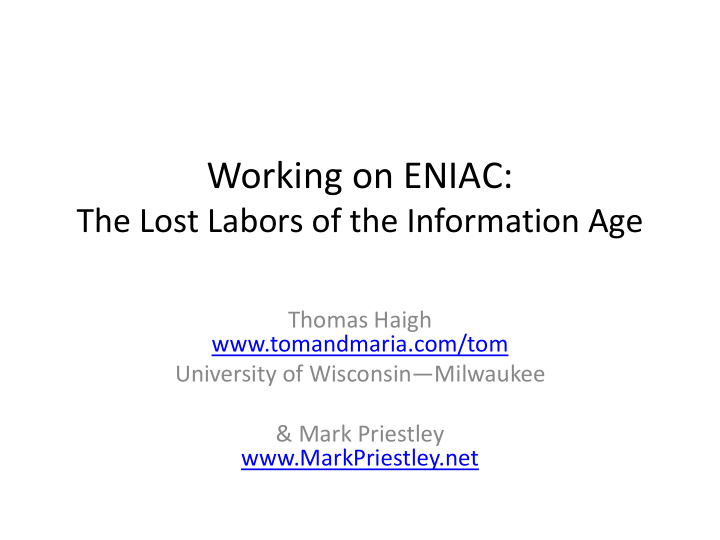



Struggling for Reliability • Frank E. Grubbs, Ph.D. student turned mathematical analyst for BRL – Pioneered statistical tests for outliers • Three weeks of computer time before first useful output produced – Intermittents – Power supplies “dumping” – Error in mathematical treatment – Time lost to hardware upgrades – Unreproducible results – Preparations for inspection by Secretary of Army www.EniacInAction.com
ENIAC Operations Log • Preserved, but never used by historians previously www.EniacInAction.com
Homer Spence • Original an army technical assigned to ENIAC • Returned to BRL as civilian employee • Spence “detected so many cold solder joints that he simply went through and resoldered every joint on the machine.” www.EniacInAction.com
Usable Machine Time www.EniacInAction.com
UPGRADES TO ENIAC www.EniacInAction.com
New Programming System • From March 1948 ENIAC control switches and wires no longer moved • Programs were written as numerical codes read and executed from addressable memory • First modern computer program ever run! www.EniacInAction.com
A complex human-readable text, written in 1948 by Klára von Neumann Many different layers of information Added to and amended over time Central repository of information about the program
ENIAC read only the 2-digit codes, set on switches by operators
Earlier ENIAC “programs” are tables or diagrams
that tell you how to set up ENIAC for a specific problem
With ENIAC’s successor, the EDVAC, programming takes a linguistic turn
ENIAC is set up to read and interpret an EDVAC-style numerical code
Marginal notes on the listing cross-reference a flow-diagram used to plan the program
Similar diagrams were used from before the conversion
Annotations on the listing document a step-by- step “paper run” to check the code
that we can replicate on an emulator
Other dimensions of the program include What did it do? A Monte Carlo simulation of chain reactions in nuclear material How did it do it? Complex program structure (c. 800 instructions), including a subroutine to generate pseudo-random numbers …
Moore School Programming Group • Set up March 1947 here, under contract to BRL – First leader was Jean Bartik, who didn’t want to leave Philadelphia with ENIAC – Worked on applications and on “converter code” – Probably the first time anyone was hired specifically to do programming www.EniacInAction.com
Core Memory • ENIAC’s biggest limitation was its tiny writable electronic memory • “Register” delay line memory ordered 1947. Delivered, but never worked. • Random access static core memory delivered by Burroughs corporation 1953 www.EniacInAction.com
DATA PROCESSING OPERATIONS WORK IN THE 1950S & 60S www.EniacInAction.com
The Computer Enters Business www.EniacInAction.com
Computers Installed in the USA 1959-1965 (cumulative) 25000 20000 Number of Installations 15000 Large Medium Total 10000 5000 0 1959 1960 1961 1962 1963 1964 1965 1966 In 1959 there are 45,000 punched card installations. In 1962, IBM revenue from computer products overtakes that from punched card products www.EniacInAction.com
Data Processing Staff, 1971 Data Processing Management 5% Analyst Key Punch 9% 31% Analyst/ Programmer 11% Punched Card Programmer 2% 17% Operations 25% www.EniacInAction.com
CONCLUSIONS www.EniacInAction.com
Female Pioneers • Underrepresentation of women in IT has inspired a hunt for female role models and pioneers • Historical figures become figureheads for events – Ada Lovelace (Day) – Grace Hopper (Celebration of Women in Computing) • The “women of ENIAC” increasingly celebrated as “the first programmers” – Proof that women can program www.EniacInAction.com
“The Women of ENIAC” • Title of 1996 article by W. Barkley Fritz – Fragments of memoirs from many women who worked on ENIAC • Kathryn Kleiman works for years on a film, bringing more attention – Esp. 1996 a 1996 WSJ column by Tom Petzinger • Jennifer S. Light 1999 paper “When Computers Were Women” www.EniacInAction.com
Now Applied Narrowly • “Women of ENIAC” = the first six operators – Not the women who built ENIAC – Or Adele Goldstine who wrote the manual and trained & recruited other women – Or Klara von Neumann, who coded the first modern program ever run – Or the many later operators and programmers at BRL www.EniacInAction.com
Walter Isaacson • “All the engineers who built ENIAC’s hardware were men…” • “ all the programmers who created the first general- purpose computer were women .” www.EniacInAction.com
Still forgotten? www.EniacInAction.com
Google “first programmers” • Top hit is Ada Lovelace • Next six hits are the ENIAC women • But… Nobody celebrates the “first computer operators.” www.EniacInAction.com
Girls Who Code vs. Women Who Operate • We can’t fix the “Great Man” view of history by adding a few “Great Women” – Insistence on genius and innovative breakthroughs • By 1950s, computer operations and keypunch work seen as almost blue collar – Also the computer work most likely to be done by women • “ reclaiming these women as the first programmers…glosses over the hierarchies...among operators, coders, and analysts .” (Wendy Hui Kyong Chun) www.EniacInAction.com
Recommend
More recommend